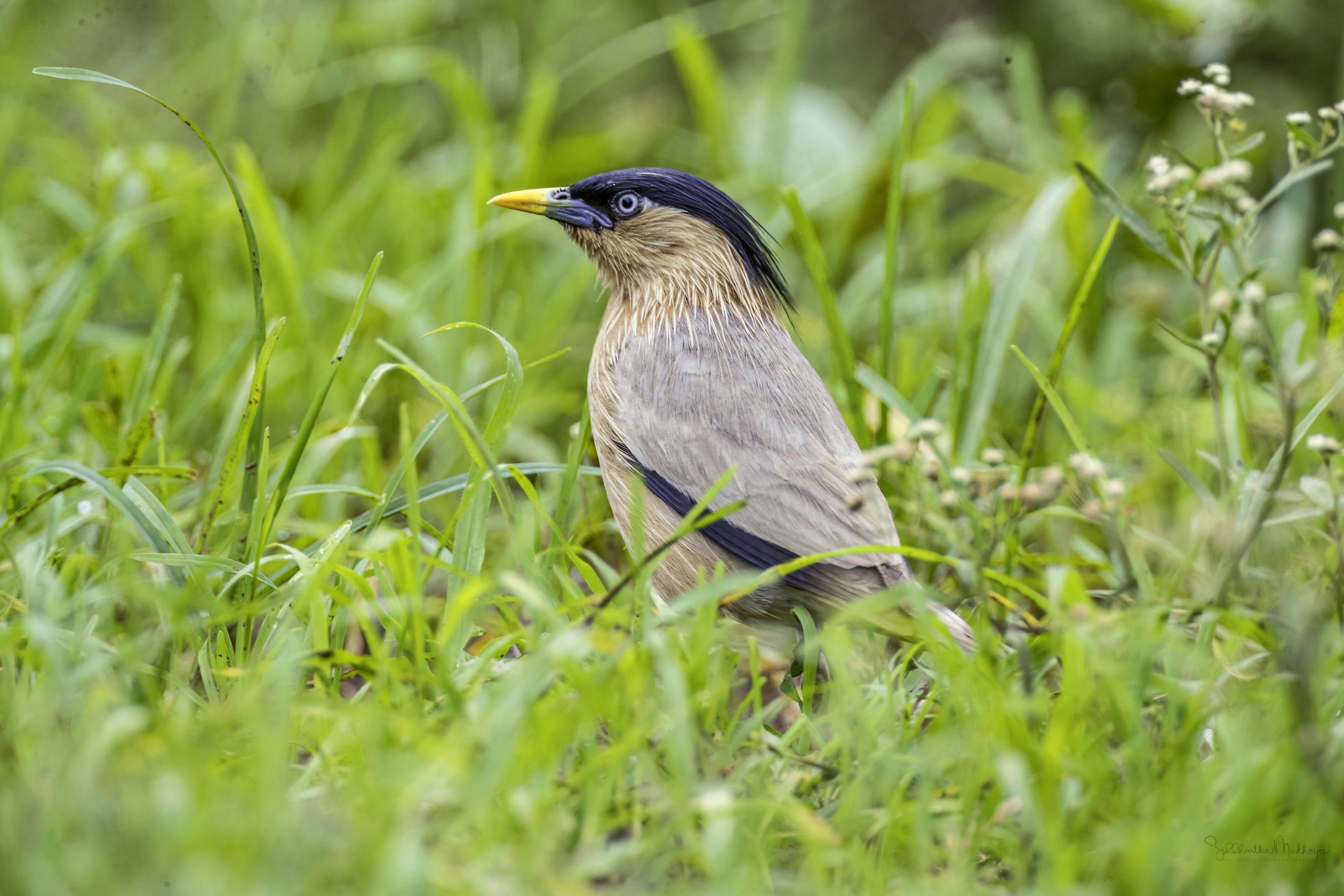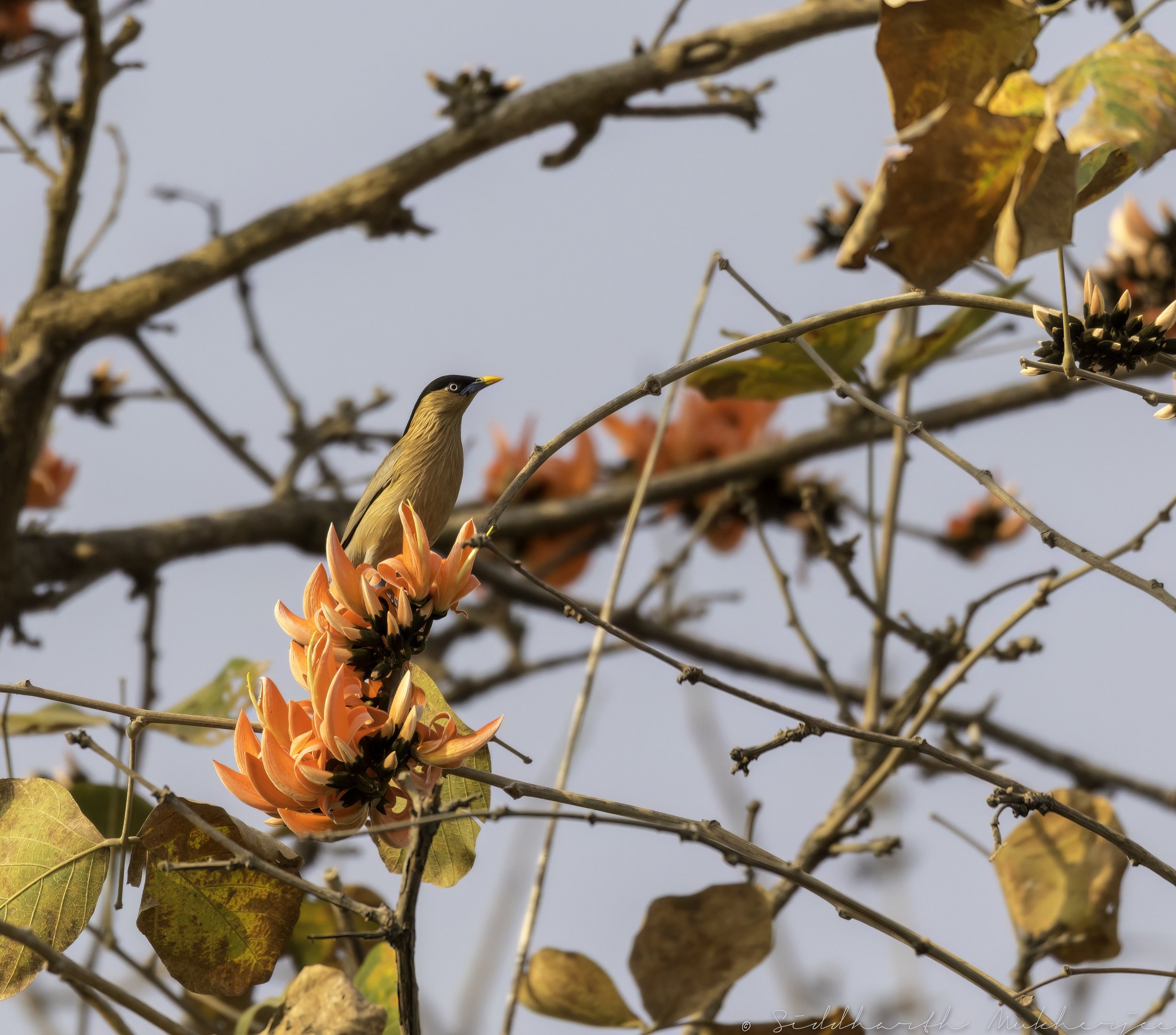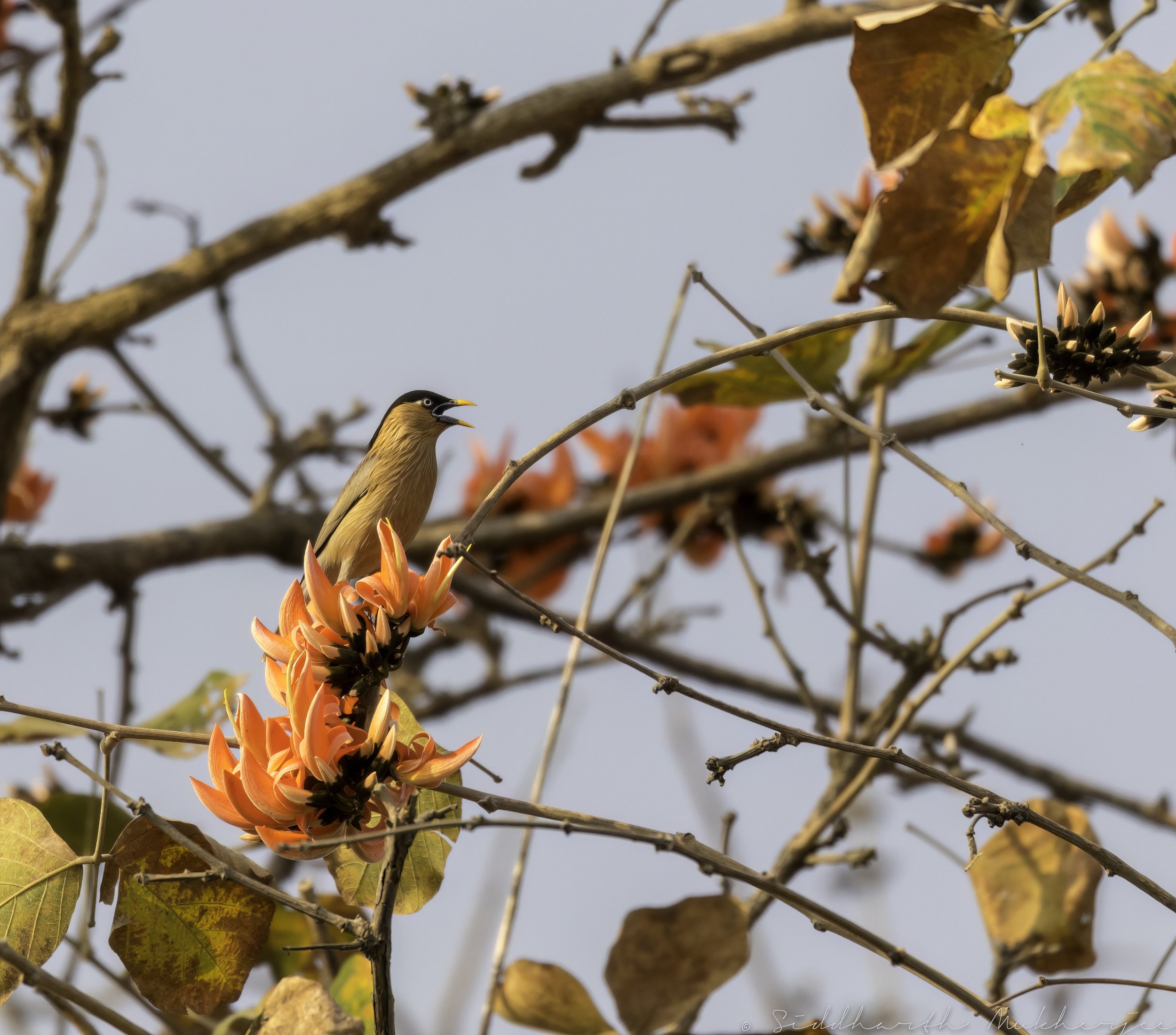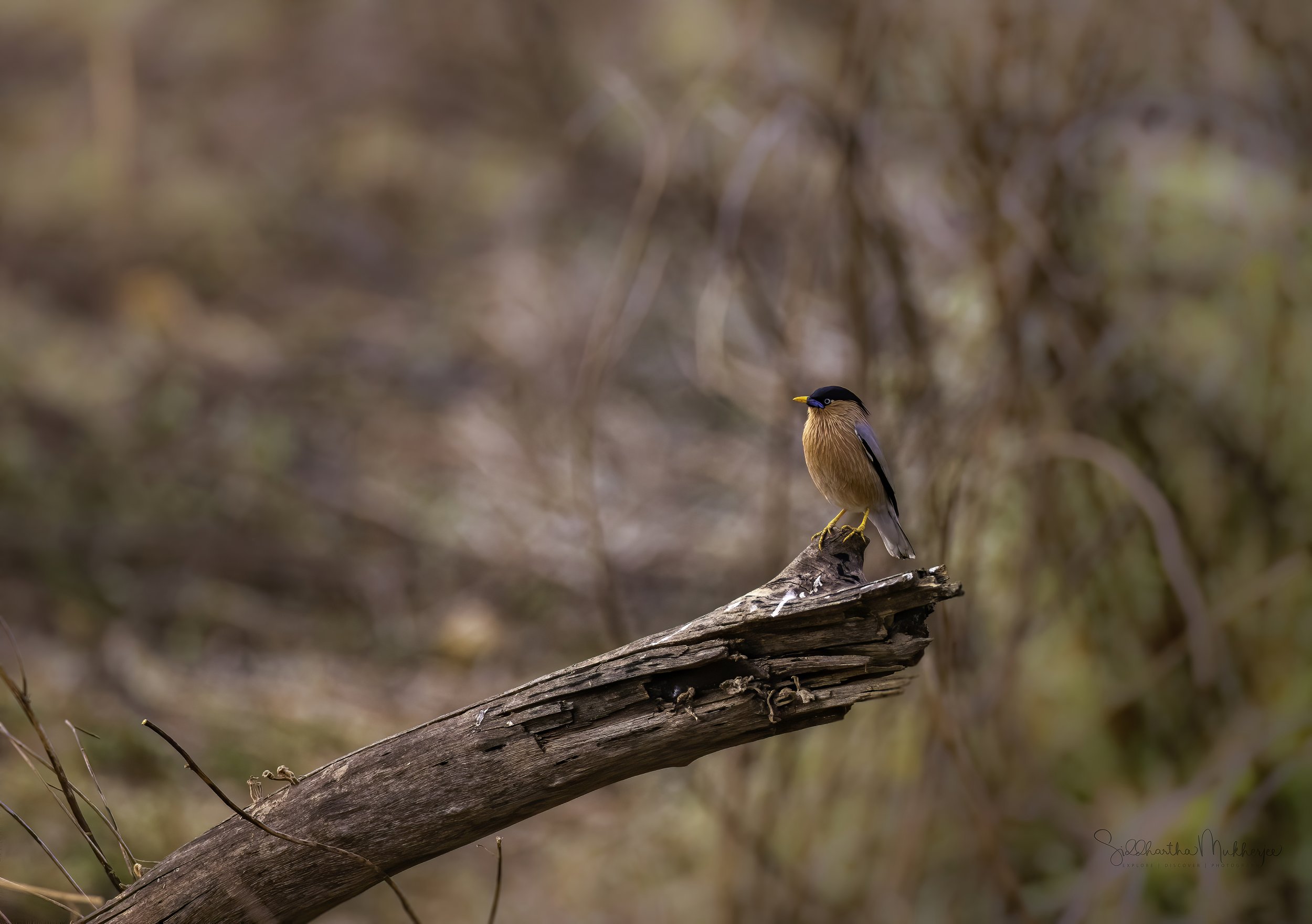Brahminy Starling
Sturnia pagodarum
Narsapur Forest Range, Telangana
Today we return again to the neighbouring forests of Narsapur where I had spotted, on an earlier trip, the Small Minivet (Pericrocotus cinnamomeus) - a bird belonging to the family of cuckooshrikes and minivets, the Campephagidae.
An interesting experience this one. I was on my own and arrived well before dawn and was in position on an embankment beyond a small dried pond. This pond has always piqued my curiosity because when it does fill with water it is a natural deterrent and slightly isolates a couple of trees of the wild guava and a lantana bush. There are very good perches and it is also in this general vicinity that I had earlier photographed the beautiful Black Redstart.
I was standing quietly as dawn broke on a lovely wintery Saturday when I spotted a familiar bird come and perch on a tree to my left. I found it again and took a few pictures. The Brahminy Starling is a small fawn-colored starling with a long wispy crest that usually lies limp over the back of its head, but the feathers on its cheek and upper breast stand up and away from its cheek. Note the yellow bill with a blue base. Often seen in small family groups, feeding on fruits and nectar as well as insects on the ground or in the trees. They have a wide repertoire of calls and are also given to mimicking other species.
Located in the Deccan Plateau in the central stretch, the prosperous state of Telangana has sub-tropical climate and the terrain consists mostly of hills, mountain ranges, and thick dense forests covering an area of 27,292 km². The annual rainfall ranges between 1,100 mm to 1,200 mm and the annual temperature varies from 15 C to 45 C. The state is drained by a number of rivers which include the Godavari and the Krishna.
Telangana is endowed with rich diversity of flora and fauna. It has dense teak forests on the northern part along the banks of river Godavari. As per the Champion & Seth Classification of Forest Types (1968), the forests in Telangana belong to three Forest Type Groups, which are further divided into 12 Forest Types. The State Government has taken up a massive greening programme, 'Telangana Ku Harita Haram' in the State to plant and protect 230 crore seedlings over a period of 4 years. This initiative aims at achieving the twin objectives of increasing the forest cover and reduce pressure on the existing forest resources, through massive community participation by Vana Samrakshna Samithis (VSS) and Eco-Development Committees (EDCs) in Protected Areas and Watershed Development Committees in the Watershed areas. Recorded Forest Area (RFA) in the State is 26,904 km² of which 20,353 km² is Reserved Forest, 5,939 km² is Protected Forest and 612 km² is Unclassed Forests. In Telangana, during the period 1st January 2015 to 5th February 2019, a total of 9,420 hectares of forest land was diverted for non-forestry purposes under the Forest Conservation Act, 1980 (MoEF & CC, 2019). As per the information received from the State during that last two years, 12,730 ha of plantations including avenue plantations in the State.
Three National Parks and nine Wildlife Sanctuaries constitute the Protected Area network of the State covering 5.08% of its geographical area.
The Narsapur forest range is spread over 30 km² at an easily drivable distance of 45 km from Hyderabad, the state capital. It is brimming with a plethora of exquisite and fragrant flora and fauna, natural rock formations, ponds and which is at its best during the monsoons. There are small steep elevations which are easy to climb and invariably most of these begin at a temple in the forest. There is also the Narsapur Forest Urban Park with a watchtower in close proximity which provides stunning views of the whole forest. Our sojourn starts at one of these temples just off the highway where we park our cars and trek into the forest. The area surrounding and in close proximity of the temple is teeming with bird life and if one has the patience one is assured of spotting numerous species as they forage in the foliage.
Brahminy Starling
The Brahminy Starling (Sturnia pagodarum) is a member of the starling family of birds. It is usually seen in pairs or small flocks in open habitats on the plains of the Indian subcontinent. It is a small fawn-colored starling with a long wispy crest that usually lies limp over the back of its head, but the feathers on its cheek and upper breast stand up and away from its cheek. Its upperparts are gray and the dark tail is tipped in white. Note the yellow bill with a blue base. It is often seen in small family groups, feeding on fruits and nectar as well as insects on the ground or in the trees. They have a wide repertoire of calls and are also given to mimicking other species.
The Brahminy Starling was formally described in 1789 by the German naturalist Johann Friedrich Gmelin in his revised and expanded edition of Carl Linnaeus's Systema Naturae. He placed it with the thrushes in the genus Turdus and coined the binomial name Turdus pagodarum. The specific epithet pagodarum is Modern Latin meaning "of the temples" or "of the pagodas". Gmelin based his account on the "Le Martin Brame" that had been described in 1782 by the French naturalist Pierre Sonnerat in his book Voyage aux Indes orientales et à la Chine. Sonnerat mentioned that the bird was found on the Malabar and Coromandel Coasts of India.
It was formerly placed in the genus Sturnus. A molecular phylogenetic study published in 2008 found that the genus was polyphyletic. In the reorganization to create monotypic genera, the Brahminy Starling was one of five starlings moved to the resurrected genus Sturnia that had been introduced in 1837 by René Lesson. The species is monotypic and no subspecies are recognised.
This starling is pale buff creamy with a black cap and a loose crest. The bill is yellow with a bluish base. The iris is pale and there is a bluish patch of skin around the eye. The outer tail feathers have white and the black primaries of the wings do not have any white patches. The adult male has a more prominent crest than the female and also has longer neck hackles. Juveniles are duller and the cap is browner.
The species name pagodarum is thought to be based on occurrence of the species on buildings and temple pagodas in southern India.
The bird is about 20 cm long and weighs between 40–54 grams. It is a distinctive small starling with a long wispy crest formed by elongate and hackled crown feathers. The feathers of the nape and those of the upper breast are also hackled. The male has its forehead and crown a glossy black, the nape is cinnamon with pale shaft streaks (the nape is often concealed by the long crown feathers). The mantle, back and rump are grey, tinged brown while the upperwing-coverts are grey, tinged with brown. The primaries a dull brownish-black with some white at the base and the tail is grey-brown, all except central feather pair with white tip, the white area becoming broader on outer feathers, particularly outer web of outermost feather; side of neck, chin, throat and underparts cinnamon, feathers of upper breast with pale shafts (streaked effect), flanks grayer. The iris is pale greenish with a small bare patch of whitish skin behind the eye and the bill is yellow distally, bluish basally, often with some dull greenish in between; legs are lemon-yellow. The female is very like male, but with a shorter crest, shorter hackles and a darker mantle. The juvenile is duller and browner on the back, has a brown crown without crest or hackles, buffer underparts, grey iris and the bill lacks blue at the base, tarsi pinkish.
It is a resident breeder in Nepal and India, a winter visitor to Sri Lanka and a summer visitor in parts of the western and northeastern Himalayas. They are spotted in the plains of Pakistan as well. They have musical call notes that are long, made up of a series of slurred notes that end abruptly. Although mainly seen on the plains, there are a few records from above 3,000m, mainly from Ladakh. Their documented distribution ranges from extreme SE Tajikistan (Ishkashim region), NE Afghanistan E in foothills to Eastern Nepal and West Bengal, South to East Pakistan and throughout peninsular India; non-breeding also in Sri Lanka.
This passerine is typically found in dry forest - open deciduous forest, scrub jungle and cultivation and is often found close to human habitations. They especially favour areas with waterlogged or marshy lands. Lowlands and hills, to 1800 m.
They are presumed resident over most of their range. In the North, summer migrant, arriving in Apr–May in Afghanistan and Kashmir East to North India. There are som seasonal movements, as in Goa, they may be associated with the monsoon. They are a non-breeding visitor in Sri Lanka with reported vagrants in SW Myanmar, S Thailand, Singapore and S China (Yunnan) possibly escaped cagebirds.
Like most starlings, the Brahminy Starling is omnivorous, eating fruit and insects. They have been known to feed on the fruits of Thevetia peruviana - commonly known as 'Pili Karen's or Yellow Oleander because of their yellow flowers and is found throughout India. It is commonly known as Kaner, lucky nut, yellow oleander and milk bush - which are toxic to many vertebrates. These birds are not as arboreal as the grey-headed mynas and they form small flocks that mix with other mynas on grass covered ground. They sometimes forage beside grazing cattle. They also visit flowers for nectar, particularly Salmalia (Shalmali (Salmalia malabarica), also called Silk cotton tree, Indian Kapok tree, Semal, Buruga, Sittan, Unnamurika or Sanmali is an Ayurvedic herb that is loaded with health benefits.), Butea monosperma (commonly known as the "flame of the forest". It's also known by other names in different languages, including Palash in Marathi & Bengali), Dhak in Hindi, Muthugada mara or Paalasha in Kannada, Palasin panatha in Malayalam, Porasu in Tamil, Modugu in Telugu) and Erythrina (commonly known as the coral tree, tiger's claw, and lucky bean tree). They roost communally in large numbers in leafy trees, often in the company of parakeets and other mynas. The nestlings fed mainly with animal food, especially insects such as termites, moths, grasshoppers, also beetles, flies, bugs, ants, bees and wasps, earwigs, cockroaches; also spiders (Araneae), millipedes (Diplopoda) and earthworms (Annelida); some plant matter, including seeds and pulp of Azadirachta indica, Lantana camara, Luffa cylindica, Ficus and leaves of Peltoforum pterocarpum, fed to young. They forage extensively on the ground.
It builds its nest in tree holes or artificial cavities. The breeding season is March to September but varies with location, being earlier in southern India. The season coincides with the fruiting of many plants and the young hatch just as the rains begin. The male selects the nest, sometimes having to compete with other hole-nesters such as barbets and sparrows. The male displays by puffing up feathers, fanning the tail, erecting the crest and raising up its bill. Both sexes take part in nest building. The nest is lined with grass, feathers and rags. The normal clutch is three to four eggs which are pale bluish green. The females do not add replacement eggs when eggs are removed nor do they stop laying if an egg is artificially added. Incubation begins only after laying the second egg with the female brooding at night with the male share limited to brief periods during the day. The eggs hatch in about 12 to 14 days. The young fledge and leave the nest when they are three weeks old. The young are fed with insects in the early stages and grains in the later stages. After feeding the parents wait for the young to eject faecal pellets which they carefully remove and drop about 20 metres away from the nest. Two or three broods may be raised in succession.
Their song includes a huge variety of different notes and mimicry of other species, also repeated short phrases, each verse often introduced with a nasal slurr, given from perch and from ground (in different contexts); loud territorial song in short phrases, a softer advertising song, and extended song with complicated structure given by both members of pair during courtship. Calls include a series of rapidly repeated harsh shrieks, sometimes preceded by nasal note; alarm call a grating "churr", repeated in short series.
The Brahminy Starling is not globally threatened and classified as Least Concern. They are locally common, and may be expanding their range in the North. The first recorded breeding in South East Tadzhikistan was in 2011. There are a few scattered reports from NE India and Bangladesh but these need to be corroborated. Claims of former breeding in Sri Lanka questioned; now a rare and mainly coastal non-breeding visitor there. Kept as cage bird in India.
‡‡‡‡‡
Related Posts
























